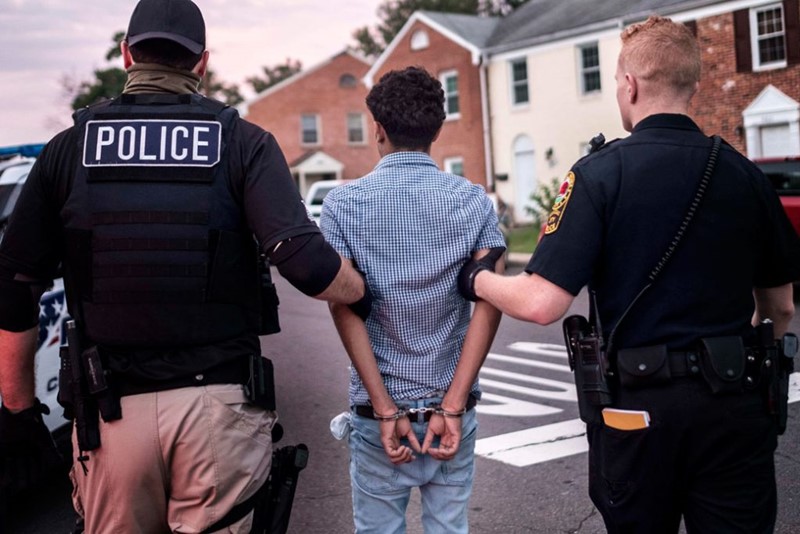
At his inauguration, President Donald Trump painted a bleak picture of America, blaming “gangs and drugs” for causing “American carnage.”1 As explained in a recent Center for American Progress column, since entering politics, Trump has exaggerated the threat of violent crime and street gangs such as MS-13 in order to gain support for his policies.2 While politicians have long used racialized fear tactics to sell tough-on-crime policies, Trump’s use of them stand out as particularly explicit and detached from facts. The president’s specious claims have come at too great a cost for black and Latino communities, both of which are often on the receiving end of punishing criminal justice and immigration enforcement systems in the United States.
Trump’s rhetoric surrounding the issue of gang violence contradicts evidence on street gangs and violent crime. Today, violent crime overall is on the decline, decreasing substantially since it peaked in the early 1990s.3 While particular areas in some jurisdictions continue to experience high rates of violent crime, that is not the case for the majority of the country.4 Similarly, the threat of national gangs has declined, and gang activity overall has fallen sharply since the 1990s.5 Today, street gangs are often local neighborhood threats rather than nationwide menaces. Even MS-13 numbers are relatively small in comparison to other national gangs, comprising just 0.7 percent of all gang membership in the United States.6 The truth is that the MS-13 gang has not grown in size over the past decade.7 It is responsible for less violence than other national street gangs, and its victims are usually other community members, not random individuals from outside the communities in which the gang members live. Despite the gang’s violent activity in specific regions, MS-13 has not reversed the overall trend of dwindling violent crime in the country.8
Nonetheless, in order to implement a punitive and regressive policy agenda, the Trump administration has run with the myth that gangs such as MS-13 threaten everyday Americans. For instance, the administration has often cited the American-founded MS-13 gang as a reason to restrict the flow of immigrants to the United States, including Central American refugees seeking asylum from gang violence and other threats. However, experts point out that there is little evidence to suggest MS-13 takes advantage of the country’s immigration laws.9 In fact, immigrants to the United States are less likely to engage in crime than native-born Americans.10 Moreover, areas with the highest rates of immigration tend to have lower crime rates than other parts of the country.11 These claims are supported by the U.S. Department of Homeland Security’s (DHS) own numbers. For instance, two-thirds of those arrested in Immigration and Customs Enforcement’s (ICE) 2017 gang sweep were U.S. citizens.12
Public safety approaches must be based in evidence rather than fear. Without doubt, gang violence—like any violence—is devastating and should be treated as a serious priority for law enforcement. But this administration is conflating gang crime with illegal immigration, and painting communities of color as bastions of lawlessness, in a cynical effort to capitalize on fear and sell draconian tough-on-crime policies. Against this backdrop of an exploitive administration that is hostile to the rights of people of color,13 a justice system plagued with racial inequalities,14 and the reality that violent crime is on the decline, it is critical that law enforcement and lawmakers consider the ramifications of labeling someone a gang member.
This issue brief seeks to explain how jurisdictions define gang membership and to show how an all-too-often nebulous definition of gang membership, coupled with few legal safeguards, can lead to disastrous consequences for young people of color—particularly black men, Latino men, and noncitizens of color. As decades of evidence clearly show, mass criminalization is not the path to public safety.15
Defining gang membership
Gang membership in and of itself is not a crime, yet affixing gang labels is often used to criminalize black and Latino youth. The disproportionate racial impact of gang identification is particularly troubling considering that white people make up a substantial portion of gang-affiliated youth in this country but are not on law enforcement’s radar.16 Surveys of young people have shown that up to 40 percent of individuals who identify as gang members are white, but law enforcement regularly undercounts them and overcounts black and Latino youth.17 While white youth are afforded the privilege of being seen as individuals in the eyes of law enforcement, black and Latino youth are held accountable for the actions of their peers.18
There is no fixed legal definition of “gang” or “gang membership.” Since gangs and gang affiliation are so loosely defined both across the country and across law enforcement agencies, the burden of proof to be considered a gang member is often low. This is problematic because a gang label can come with crippling consequences for individuals who find themselves in the criminal justice or immigration system.
Gang membership and state and local laws
States do not consistently define gangs, but when they do, the definitions are broad. Nearly every state and the District of Columbia legislatively defines “gang.”19 As of the end of 2016, at least 36 states defined a gang as a group comprised of three or more people, and 30 states included a common name, identifying sign, or symbol as a gang identifier.20 Every state includes criminal activity as part of the definition of a gang. Most states define gang activity as well, while just a handful of states—11—define gang membership.21
Many jurisdictions define gang membership at the local level. One survey by the National Gang Center found that most law enforcement agencies consider criminal activity the main indicator of a gang.22 The survey found that a majority of law enforcement agencies—just like the majority of states that define gang membership—rely on the display of gang symbols, such as gang-associated colors and tattoos, as the greatest indicator of gang membership.23 A number of jurisdictions also use arrests and associations with known gang members, as well as self-identification of membership, as indicators of gang membership.24
On the ground, cities have come under fire for using some of these criteria to identify gang members. For instance, in New York City, the New York Police Department (NYPD) maintains a controversial gang database that, at one recent point, was 99 percent black and Latino.25 Although the NYPD has not publicly shared its process for identifying gang members, NYPD Chief of Detectives Dermot F. Shea recently testified that a person is added to the gang database if that individual admits gang membership—which can include admission on social media—or is identified as being gang-affiliated by two “reliable sources.”26 The NYPD may also enter individuals into the database if they meet two of the department’s criteria, such as frequenting a known gang location or wearing colors associated with a specific gang.27 New York does not have a statute making gang membership a crime.28 Neither does it have gang enhancement statutes on the books.29 Nonetheless, the city’s method of gang identification is overbroad, leading to racial profiling and increased police surveillance of black and Latino communities.30
Gang membership and federal law
In response to urban gang violence, Congress passed a significant crime bill in 1994 called the Violent Crime Control and Law Enforcement Act. Unfortunately, the bill’s foremost legacy is cementing a tough-on-crime approach that has perpetuated mass incarceration, contributing to a doubling of the national prison population from 1994 to 2009.31 One of the provisions of the 1994 crime bill called for stricter punishment for gang members, even though gang membership itself was not made a substantive offense.32 Federal statute, pursuant to the bill, defines a “criminal street gang” as an ongoing group of five or more individuals who have as a primary purpose the commission of one or more felonies—which members have engaged in within the past five years—and whose activities affect interstate or foreign commerce.33 Therefore, in the federal context, gang membership can lead to sentencing enhancements that result in longer sentences.34
Accusations of gang membership in the criminal justice context can be used to impose immigration consequences on noncitizens, including individuals who lack criminal records. Gang membership in and of itself is not grounds for removal under the Immigration and Naturalization Act (INA)—the body of law that governs U.S. immigration proceedings. The INA neither defines gang membership, nor does it outline specific immigration consequences for gang membership.35 In other words, gang membership alone is insufficient to make an individual deportable.36 Still, alleged gang affiliation can carry significant consequences for noncitizens, up to and including detention and deportation. This is because gang affiliation makes an individual an enforcement priority for the DHS, even in instances where that individual lacks a criminal record.
Allegations of gang membership are used in a variety of immigration-related contexts, including when individuals are applying for immigration benefits.37 Claims of gang affiliation may arise as disclosures during custodial or noncustodial interviews with DHS or as evidence presented during bond and individual hearings in immigration courts.38 Some other common consequences of gang membership allegations include being ineligible to obtain immigration relief, such as asylum, a green card for permanent residency, temporary relief from deportation under the Deferred Action for Childhood Arrivals (DACA) program, or other immigration benefits.
Unlike defendants in criminal court, respondents in immigration court do not have the right to a court-appointed attorney. Nor are there rules of evidence in immigration proceedings, making it more difficult for respondents to dispute accusations of gang affiliation.39 Furthermore, in immigration court, judges have wide discretion to decide case outcomes.
On-the-ground consequences of gang membership allegations
There are several harms attached to being labeled a gang member under one of several broad definitions. Most U.S. law enforcement agencies use some kind of gang database to keep track of alleged gang-affiliated individuals, even though these databases are notorious for being unregulated and full of errors.40 For example, a 2016 audit of California’s gang database, CalGang, revealed the inclusion of 42 individuals who were under the age of 1 when the data was entered.41 Of these individuals, 28 were added for self-admission of gang membership, which was likely the result of an error.42
Depending on the specific laws of a jurisdiction, the collateral consequences that stem from being placed on a gang database vary. Common consequences include racial profiling, increased police surveillance, longer sentences, and due process violations. In some jurisdictions, individuals may be subjected to gang enhancements or injunctions. For noncitizens, immigration benefits may be denied.
Gang injunctions and enhancements
Since the 1980s, California has used allegations of gang membership to establish gang injunctions—probation-like civil orders that target certain neighborhoods and limit the conduct and mobility of individuals who are alleged gang members.43 An injunction allows law enforcement to arrest, prosecute, and incarcerate people named in the injunction for noncriminal activity such as breaking curfew, carrying a cell phone, or hanging out with other gang-identified individuals.44 This often means that individuals are prohibited from associating with friends and even family members.45
In March 2018, a court barred Los Angeles from employing its gang injunctions, citing constitutional concerns.46 The judicial order gave credence to the argument made by individuals of the class action lawsuit, who asserted that their due process rights were violated when they were placed on a gang injunction list without being afforded the opportunity to fight allegations of gang membership in court.47 As a result of an internal audit and this lawsuit, more than 7,000 people were released from gang injunctions in 2017 and 2018.48
Gang enhancements, another common consequence of being labeled a gang member, allow courts to add additional time to a sentence if the individual committed a felony either to benefit a gang or in association with a gang in order to promote the gang’s criminal activities.49 Similar to how federal law allows U.S. attorneys to prosecute crimes with enhancements if those crimes were committed by gang members, a growing number of states have enacted gang enhancements for state crimes.50
California leads the nation in prosecuting gang enhancements.51 Being on the state’s CalGang database is itself enough to trigger gang enhancements, which is troubling considering that this gang database has come under fire for inaccurately including non-gang members on its list.52 Enhancements can range from four additional years behind bars for a minor felony to 10 additional years for a serious felony.53 What is more, in California, a person who is convicted with a gang enhancement must register as a gang member for at least five years post-incarceration, even in instances where the individual is no longer a gang member or did not claim gang membership to begin with.54
Immigrant detention and deportation
Even in instances where gang allegations do not lead to criminal consequences, they can carry serious immigration consequences for noncitizens. For instance, accusations of gang affiliation have led to serious immigration ramifications for Latino youth in Long Island, where the mingling of immigration and criminal law is even more pronounced. Long Island has experienced a greater concentration of crime from the MS-13 gang relative to the rest of the country.55 At the same time, in recent years, the city has come under scrutiny for racial discrimination, including accusations of police discrimination against Latino residents and some public schools refusing to enroll undocumented students.56
Against this backdrop, Long Island’s Nassau County and Suffolk County police departments actively pursue alleged gang members for deportation. Perhaps the most concerning instances of gang allegations are found in Long Island’s public schools. Various reports show that school administrators, school resource officers, teachers, and other school staff habitually report students merely suspected of being gang members to ICE and law enforcement.57 In many instances, parents are not notified until after officials have questioned the student.58 Any negative contact with school officials can make its way to law enforcement and ICE. This sets in motion immigration consequences for accused youth in a phenomenon known as the “school to prison to deportation pipeline.”59
Although federal law prohibits schools from sharing students’ immigration status with immigration officials, school officials often take their cue from law enforcement and use broad criteria to identify alleged gang members to police.60 Some actions that caused school officials to report students to law enforcement, and subsequently led ICE to detain these students, include: scribbling El Salvador’s area code—503—in a notebook; wearing a Chicago Bulls jersey or drawing bull horns on a calculator; and posting the Salvadoran flag on Facebook.61 Some students have also been labeled “gang-associated” and were targeted by law enforcement and ICE for merely talking to known gang members at school without officials knowing the content of the conversation.62 At the end of last year, a federal judge ruled that several Long Island teenagers be released from immigrant detention, determining that their due process rights were violated after being labeled gang members on flimsy evidence.63
Conclusion
Without doubt, gang crime—like all crime—is serious and merits law enforcement attention. Nonetheless, the methods of gang enforcement discussed in this brief do not meaningfully improve public safety and come at too great a cost for young black and Latino individuals who must live with the severe consequences that stem from gang identification. Violent crime in the United States is trending at a historic low—even among youth.64 In order to continue this trend, it is imperative that jurisdictions rethink their approach to tackling crime from a smart criminal justice perspective.
Editort's Note: Maritza Perez is the senior policy analyst for Criminal Justice Reform at the Center for American Progress


